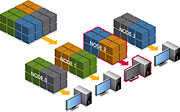- Number 338 |
- May 30, 2011
Fewer faults for faster computing

By storing the data in redundant
blocks, at least one copy of the
data remains available for use
after a computer glitch.
Whether you’re tending your crops in Farmville or seeing how atoms interact, computer glitches can result in lost time, lost data, and extreme frustration. For those studying complex chemical issues, scientists at DOE’s Pacific Northwest National Laboratory have designed a new approach that stretches out the time between these computer faults. Their approach enables the program to continue working, using Global Arrays which allows the computer to access blocks of data, bypassing the faulty areas.
The team’s approach does not stress the system, adding less than 10% to the amount of time the computational process requires. While the approach was demonstrated on NWChem, developed at EMSL, the approach can be deployed to a host of computational chemistry programs. This new approach will enhance the nation’s ability to address climate change, energy sources, and other national issues.
[Kristin Manke, 509.372.6011,
kristin.manke@pnl.gov]
